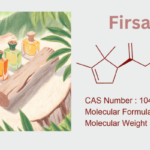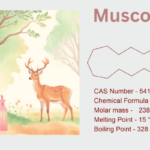1. Introduction: Geraniol’s Timeless Allure
For more than a century, geraniol, a monoterpene alcohol with a bright rose-like scent, has been a mainstay of cosmetics and fragrance. This molecule, which is found in the most fragrant flowers in nature and was artificially refined in laboratories, represents the union of chemical creativity with botanical beauty. Geraniol’s adaptability and allure continue to influence the olfactory world, from the petals of roses to the pages of high couture perfume formulae. The chemistry of geraniol, its transformation from plant to perfume, and its ongoing use in creating enticing fragrances are all covered in this article.
2. Chemical Identity: The Molecular Essence of Geraniol
Geraniol (C₁₀H₁₈O) is a monoterpenoid alcohol belonging to the terpene family. Its structure includes:
- A hydroxyl (-OH) group is located at position 3 of a 10-carbon skeleton.
- Double bonds are a transfiguration between carbons 2 and 3 (α-geraniol) or 3 and 4 (β-geraniol).
- Isomerism is the presence of citronellol (dihydrogeraniol) in hydrogenated forms.
Geraniol’s floral sweetness and moderate volatility (boiling point: 229°C) make it ideal for middle notes in perfumes.
3. Synthesis of Geraniol: Nature and Laboratory in Harmony
Natural Extraction
- Steam Distillation:
- Sources: Rose geranium (Pelargonium graveolens), palmarosa (Cymbopogon martinii), and citronella.
- Process: Geraniol from plant material is vaporized by steam, condensed, and separated.
- Yield: Palmarosa oil contains ~70–90% geraniol; rose geranium yields ~20–40%.
- Solvent Extraction:
- CO₂ Supercritical Extraction: Preserves delicate aroma compounds for high-end perfumery.
Chemical Synthesis
- From Citral:
- Hydrogenation: Citral (from lemongrass or synthetic sources) is hydrogenated using catalysts like palladium or nickel.
- Pinene Derivatization:
- Oxidation: α-Pinene (from pine resin) is oxidized to myrtenol, then isomerized to geraniol.
- Biotechnological Routes:
- Engineered Yeast: Geraniol is produced by modified Saccharomyces cerevisiae through the mevalonate pathway.
- Sustainability: Uses renewable feedstocks like glucose, reducing reliance on petrochemicals.
4. Sources: Botanical Treasures and Industrial Ingenuity
Natural Sources
- Rose Geranium: Africa’s “poor man’s rose” yields oil rich in geraniol.
- Palmarosa: Prized in Ayurveda, its oil is a geraniol powerhouse.
- Citronella: Contains ~20% geraniol, used in insect repellents and perfumes.
Synthetic Dominance
- Cost Efficiency: Synthetics supply ~80% of commercial geraniol due to natural oils’ high cost (e.g., rose oil at ~$10,000/kg).
- Purity Control: Lab synthesis ensures consistency, free from seasonal variations.
5. Perfume Formulation: Crafting Scents with Geraniol
Role in Fragrance Pyramids
- Middle NoteUnstable top notes (citrus, herbs) and profound base notes (woods, musk) are bridged.
- Blending Synergy:
- Floral Accords: Enhances rose, jasmine, and lily.
- Fruity Undertones: Complements peach, raspberry, and apple.
Iconic Applications
- Chanel No. 5: Geraniol’s rosy warmth underpins its iconic floral-aldehyde heart.
- Dior J’adore: Amplifies the tuberose and orchid bouquet.
- Niche Perfumes: Geraniol gives Byredo Rose of No Man’s Land a realistic, dewy, petal-like appearance.
Formulation Challenges
- Oxidation: Geraniol oxidizes to geranial (citral), altering scent profiles. Solutions:
- Antioxidants: BHT (butylated hydroxytoluene) or vitamin E.
- Encapsulation: Lipid nanoparticles slow degradation.
- IFRA Regulations: Limited to 2% in leave-on products due to sensitization risks.
6. Beyond Perfumery: Geraniol’s Versatile Applications
Cosmetics
- Skincare: Antimicrobial properties aid in acne formulations.
- Haircare: Adds fragrance to shampoos while reducing scalp irritation.
Functional Products
- Insect Repellents: Citronella-based sprays take advantage of geraniol’s ability to keep mosquitoes away.
- Flavoring: FDA-approved for candies and beverages (e.g., peach sodas).
7. Challenges and Innovations
Sustainability
- Green Chemistry: Enzymatic hydrogenation reduces metal catalyst waste.
- Circular Sourcing: Upcycling citrus waste (limonene) into geraniol precursors.
Market Trends
- Clean Beauty Demand: Brands like Glossier prioritize geraniol for its “natural” appeal.
- Biotech Breakthroughs: Ginkgo and Amyris Bioworks are the first to use yeast-derived geraniol in carbon-neutral fragrances.
8. Conclusion: Geraniol’s Blossoming Future
The development of fragrance, a fusion of science and nature, is embodied in the voyage of geraniol from rose petals to bioreactors. This molecule’s versatility guarantees its place in both traditional and innovative developments as the industry embraces sustainability and transparency. According to perfumer Jean-Claude Ellena, “A molecule is a universe, but a flower is a flower.” Geraniol continues to open up countless olfactory universes with its flowery essence and synthetic accuracy.










